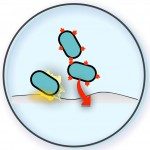Lien vers Pubmed [PMID] – 20345943
Environ. Microbiol. 2010 Jul;12(7):1957-77
Commensal and pathogenic Escherichia coli adherence to host and environmental surfaces is mediated by a variety of adhesins. Although extensively studied as a model bacterium, 34% of the genes in the E. coli K-12 genome have no known function. We hypothesized that some of them may correspond to functional adhesins. We characterized E. coli K-12 ycb, ybg, yfc, yad, yra, sfm and yeh operons, which display sequence and organizational homologies to type 1 fimbriae exported by the chaperone/usher pathway. We showed that, although these operons are poorly expressed under laboratory conditions, six of them are nevertheless functional when expressed, and promote adhesion to abiotic and/or epithelial cell surfaces. While the studied fimbriae display different binding specificities, we obtained evidence of synergy/interference with other adhesins such as Ag43 or type 1 fimbriae. We showed that their expression is under the negative control of H-NS and, except for yad, subjected to cAMP receptor protein-mediated activation and carbon catabolite repression. These results therefore demonstrate that ycb, yfc, yad, yra, sfm and yeh operons encode cryptic but functional fimbriae adhesins whose expression following environmental modifications could contribute to E. coli’s ability to adhere to and colonize a wide diversity of surfaces in its various ecological niches.






